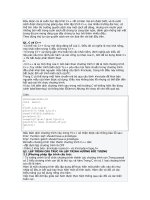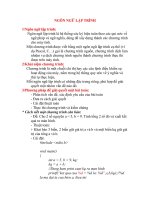Java database connectivity (JDBC) (lập TRÌNH MẠNG cơ bản SLIDE)
Bạn đang xem bản rút gọn của tài liệu. Xem và tải ngay bản đầy đủ của tài liệu tại đây (565.97 KB, 74 trang )
Java Database Connectivity
(JDBC)
Java DataBase Connectivity
• JDBC
(Java DataBase Connectivity) - provides access to
relational database systems
• JDBC is a vendor independent API for accessing
relational data from different vendors (Microsoft Access,
Oracle) in a consistent way
• The language SQL (Structured Query Language) is
normally used to make queries on relational data
• JDBC API provides methods for executing SQL
statements and obtaining results: SELECT, UPDATE,
INSERT, DELETE etc.
• Provides portability (eliminates rewriting code for different
databases and recompiling for different platforms) and
faster, reusable object developing environment
• JDBC API is part of core Java
Khoa CNTT – ĐH Nông Lâm TP. HCM 01/2007
2/46
JDBC-to-database communication
Khoa CNTT – ĐH Nông Lâm TP. HCM 01/2007
3/46
JDBC Architecture
Application
JDBC
Driver
Java code calls JDBC library
JDBC loads a driver
Driver talks to a particular database
Can have more than one driver -> more than
one database
Advantage: can change database engines
without changing any application code
Khoa CNTT – ĐH Nông Lâm TP. HCM 01/2007
4/46
Vendor specific APIs - JDBC Drivers
Database vendors provide proprietary APIs for accessing data
managed by the server. Languages such as C/C++ can make use of
these APIs to interface with the database
JDBC aims at providing an API that eliminates vendor specific nature
in accessing a database
However, JDBC still requires a vendor-specific
driver for accessing database from a particular
vendor
The driver provides interface between JDBC
API and vendor database by converting calls
from JDBC API to vendor’s database calls
Example drivers:
- JDBC/ODBC driver:
sun.jdbc.odbc.JdbcOdbcDriver
- Oracle driver:
oracle.jdbc.driver.OracleDriver
Khoa CNTT – ĐH Nông Lâm TP. HCM 01/2007
5/46
JDBC Drivers
Type
Type
Type
Type
I: “Bridge”
II: “Native”
III: “Middleware”
IV: “Pure”
Khoa CNTT – ĐH Nông Lâm TP. HCM 01/2007
6/46
JDBC Drivers
Type I
“Bridge”
Type II
“Native”
ODBC
ODBC
Driver
CLI (.lib)
JDBC
Type III
“Middleware”
Middleware
Server
Type IV
“Pure”
Khoa CNTT – ĐH Nông Lâm TP. HCM 01/2007
7/46
JDBC Driver Types
Type 1: JDBC-ODBC Bridge
• ODBC
(Open Database Connectivity) is Microsoft’s API for SQL;
popular on Windows platform
• ODBC API provides a set of functions for accessing a database
• JDBC drivers of this type translate calls from JDBC into
corresponding ODBC calls
Khoa CNTT – ĐH Nông Lâm TP. HCM 01/2007
8/46
Type 2 - Part Java, Part Native
Driver
JDBC
driver consists of java code and native code which
uses vendor-specific API for accessing databases
More efficient than JDBC-ODBC bridge due to fewer layers
of communication
Typical of this type of driver is the driver provided by IBM
for its DB2 Universal Database (UDB).
Khoa CNTT – ĐH Nông Lâm TP. HCM 01/2007
9/46
Type 3 - Intermediate Database Access
Server
Calls middleware server, usually on
database host
Very flexible -- allows access to multiple
databases
using one driver
Only need to download one driver
But it’s another server application to install
and
maintain
Khoa CNTT – ĐH Nông Lâm TP. HCM 01/2007
10/46
Type 4 - Pure Java Driver
◊ 100% Pure Java
◊ Use Java networking libraries to talk directly to
database
engines
◊ Only disadvantage: need to download a new driver
for each
database engine
◊ JDBC calls are directly translated to database calls specific to
vendor
◊ Very efficient in terms of performance and development time
Khoa CNTT – ĐH Nông Lâm TP. HCM 01/2007
11/46
JDBC Object Classes
DriverManager
Driver
a series of SQL statements to and from the DB
Statement
connects to actual database
Connection
Loads, chooses drivers
a single SQL statement
ResultSet
the records returned from a Statement
Khoa CNTT – ĐH Nông Lâm TP. HCM 01/2007
12/46
JDBC Class Usage
DriverManager
Driver
Connection
Statement
ResultSet
Khoa CNTT – ĐH Nông Lâm TP. HCM 01/2007
13/46
JDBC URLs
jdbc:subprotocol:source
each driver has its own subprotocol
each subprotocol has its own syntax for
the source
jdbc:odbc:DataSource
e.g. jdbc:odbc:Northwind
jdbc:msql://host[:port]/database
e.g. jdbc:msql://example.com:4333/empl
Khoa CNTT – ĐH Nông Lâm TP. HCM 01/2007
14/46
JDBC Driver Manager
JDBC key components: DriverManager, Connection, Statement,
ResultSet
DriverManager handles communication with different drivers that
conform to JDBC Driver API.
- The static class DriverManager manages the loaded drivers
and contains methods for accessing connections to the
databases
Khoa CNTT – ĐH Nông Lâm TP. HCM 01/2007
15/46
Four steps in creating a database
application
Step 1: load a database driver
Step 2: make a database connection
Step 3: create and execute SQL
statement
Step 4: process the result set, if
necessary
Khoa CNTT – ĐH Nông Lâm TP. HCM 01/2007
16/46
Step 1: Loading a Driver
A driver is always needed to obtain a connection
Loading a driver requires class name of the driver.
For JDBC-ODBC driver the class name is:
sun.jdbc.odbc.JdbcOdbcDriver
Oracle driver is: oracle.jdbc.driver.OracleDriver
The class definition of the driver is loaded using forName static
method of the class Class (in package java.lang)
try {
Class.forName("sun.jdbc.odbc.JdbcOdbcDriver");
} catch (Exception e) {
out.println( e.getMessage() + "\n Class not found Exception.");
}
It is possible to load several drivers to access various databases
(see for vendors list at java.sun.com/products/jdbc )
The class DriverManager manages the loaded drivers
Khoa CNTT – ĐH Nông Lâm TP. HCM 01/2007
17/46
Step 2: Opening a Database Connection
• getConnection method of DriverManager class returns a
connection
• When there are several databases used by the same
application, the driver required to access the database is
uniquely identified using JDBC URLs
JDBC URL: Represents a driver and has following three-part
syntax
Examples:
"jdbc:odbc:books” : specifies database books as ODBC data
source (books is a logical name linked to actual database)
Khoa CNTT – ĐH Nông Lâm TP. HCM 01/2007
18/46
Step 2: Opening a Database
Connection(contd.)
• Getting a connection to ODBC data source books (MS
Access database)
• DriverManager
has other variants of getConnection
method that accept different set of parameters
• Connection is an interface defined in java.sql package. A
Connection object represents a connection with the
database. The interface has methods to create statements
which can be used to manipulate the database
Khoa CNTT – ĐH Nông Lâm TP. HCM 01/2007
19/46
Step 3: executing SQL Statements
• Connection objects can be used to create statement objects.
statement = connection.createStatement();
• Statement is an interface that contains methods for executing SQL
queries
• sqlStr contains a string which is an SQL statement for inserting a new
record in the table Authors in the books database
• The SQL statement is executed using executeUpdate method of the
statement object
• The method is used to execute statements like INSERT, UPDATE,
DELETE that do not return any results. It returns number of rows affected
• Authors is one of the tables in the books.mdb database. Books,
Quotations, Topics are some of the other fields.
The Authors table consists of four fields
• Authord Id, first name, last name and notes. In the above example, they
have the values ’5’ , ‘Walter’, ‘Lippman’ and ‘Journalist’ respectively
Khoa CNTT – ĐH Nông Lâm TP. HCM 01/2007
20/46
Step 4: Enquiring the Database
• The
Statement object returns a java.sql.ResultSet object upon
executing an SQL statement using executeQuery method
• The method returns all rows in Authors table as a ResultSet
• The next() method of ResultSet allows to move from one row to the
next
while (rs.next()) {
// rs stands for a row in each iteration; print author details
}
• ResultSet contains several methods for extracting various fields in a
row. The methods require column name or column index as an
argument. The method used depends on type of the field. For example,
author’s first name can be obtained by
rs.getString( "FirstName" )
FirstName is the name of the field assigned while creating the
database. The method returns author’s first name which is a string
Khoa CNTT – ĐH Nông Lâm TP. HCM 01/2007
21/46
Register a database as an ODBC Data
Source
• The computer should have Microsoft Access installed
• Invoke ODBC Data Source Administrator:
• In Windows Control Panel, double click “ODBC Data Sources”. • The
dialog is used to register user data source name. The tab User DSN
must be selected
• Since a new data source is to be created, click Add in the dialog. Create
New Data Source dialog appears.
• There are several drivers listed in the dialog including dBase, Oracle,
Microsoft Access etc. books is a Microsoft Access database. So, select
Microsoft Access Driver and click Finish.
• Another dialog ODBC Microsoft Access Setup appears.
• In the field Data Source Name enter a name by which the database is to
be referred in JDBC program. In the example, the name books is used.
• This name should be associated with an actual database. Click Select
button. This displays Select Database dialog which allows to select a
database on the local file system or across the network.
• Click OK to dismiss the Select Database dialog and return to ODBC
Microsoft Access Setup
Khoa CNTT – ĐH Nông Lâm TP. HCM 01/2007
22/46
Registering as an ODBC Data
Source
• Click Advanced button in ODBC Microsoft Access Setup dialog.
Set Advanced Options dialog appears
• Enter authorisation information Login name and Password. In
this example, the login name is anonymous and password is guest
• Click OK to dismiss the dialog
• Dismiss the ODBC Microsoft Access Setup dialog by clicking
OK.
• Now ODBC Data Source Administrator dialog contains data
source books with Microsoft Access Driver associated with it.
• Now the database can be accessed using JDBC-ODBC bridge
driver
Khoa CNTT – ĐH Nông Lâm TP. HCM 01/2007
23/46
JDBC key components
Khoa CNTT – ĐH Nông Lâm TP. HCM 01/2007
24/46
The DriverManager Object.
Once a driver is installed, you need to load it
into your Java object by using the
DriverManager. It provides a common interface
to a JDBC driver object without having to
delve into the internals of the database itself
The driver is responsible for creating and
implementing the Connection, Statement, and
ResultSet objects for the specific database.
DriverManager then is able to acquire those
object implementations for itself. In so doing,
applications that are written using the
DriverManager are isolated from the
implementation details of databases.
Khoa CNTT – ĐH Nông Lâm TP. HCM 01/2007
25/46









